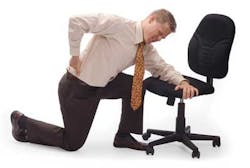The economics of ergonomics: 3 steps to maintain longevity throughout your dental career
Whether it is related to years of poor posture by constantly hunching over (while working on patients) or lack of exercise to maintain muscle strength, or both, understanding the consequences of neglectful ergonomics is imperative to maintaining a productive work environment.
According to Dr. Sanaz Rouhani, a Los Angeles-based chiropractor, “Steps should be taken to focus on prevention of back injuries. Working with a personal trainer to strengthen back muscles and visiting a chiropractor for routine adjustments is key. Ignoring lingering back pain could lead to chronic pain.”
As dentists, we are constantly on the move going from room to room. Being idle is not in our repertoire. Any form of lingering or chronic pain can lead to significant time lost at work. Missing work to rehabilitate from a sudden back injury or finally deal with pain once it becomes chronic could be significantly deleterious to one’s bottom line.
How you'll lose income
Missing work due to disability can result in lost income and, in many instances, it takes at least 90 days to receive a claim benefit. According to The Journal of Pain, the reported annual cost of chronic pain is as high as $635 billion a year, which is more than the yearly costs of cancer, heart disease, and diabetes. Mean health-care expenditures for adults were $4,475 in 2012.
You might also want to read: Ergonomics and dental hygiene: It's all in how you say it
Dr. Dan Pedersen, an Irvine, Calif.-based dentist adds, “It’s important for dentists to have a structured work-out routine and go the gym routinely to focus especially on upper body strength. Personally, I go to the gym at least four days a week.” If injuries do occur, it’s imperative to seek treatment. Dr. Michael Welcome, an Irvine, Calif.-based dentist says, “Four years ago, I woke up with a rib pointer that was sticking out of my upper back. The pain lasted at least a month, and I had to get physical therapy and visit the chiropractor routinely.”
As dentists advance in their careers and keep up with the latest and greatest technology, it is essential to be proactive regarding their own back health. Taking these three essential steps can help you maintain longevity throughout your entire dental career: maintain proper posture, use magnification, and receive physical therapy. Visiting a chiropractor for frequent adjustments is also imperative. After all, they have your back.
Originally published in 2015 and updated regularly
About the Author

Iman Sadri, DDS
Dr. Iman Sadri is the founder of @HollywoodSmileTV and maintains a private practice in Southern California.
Bio updated April 11, 2017
